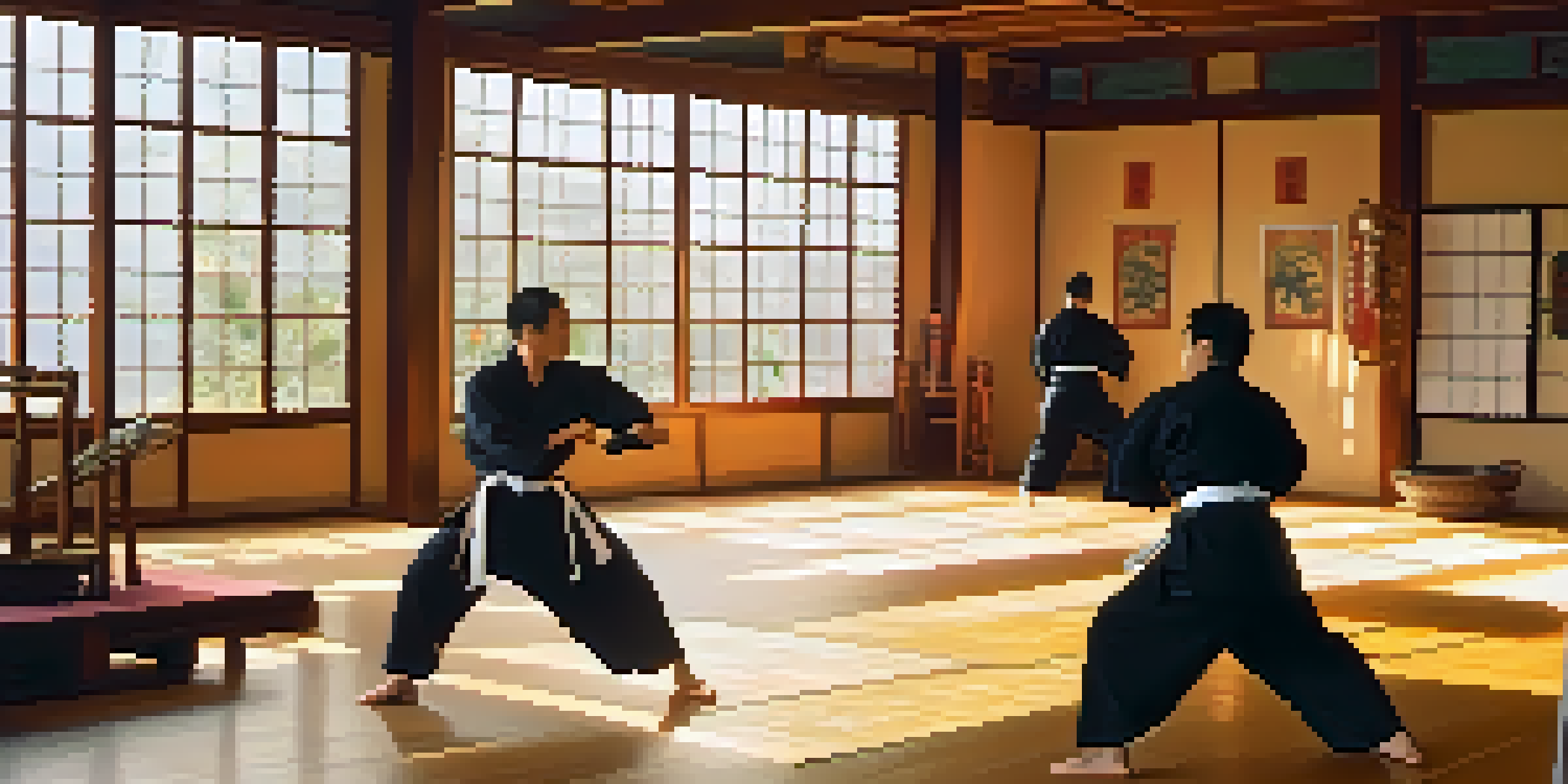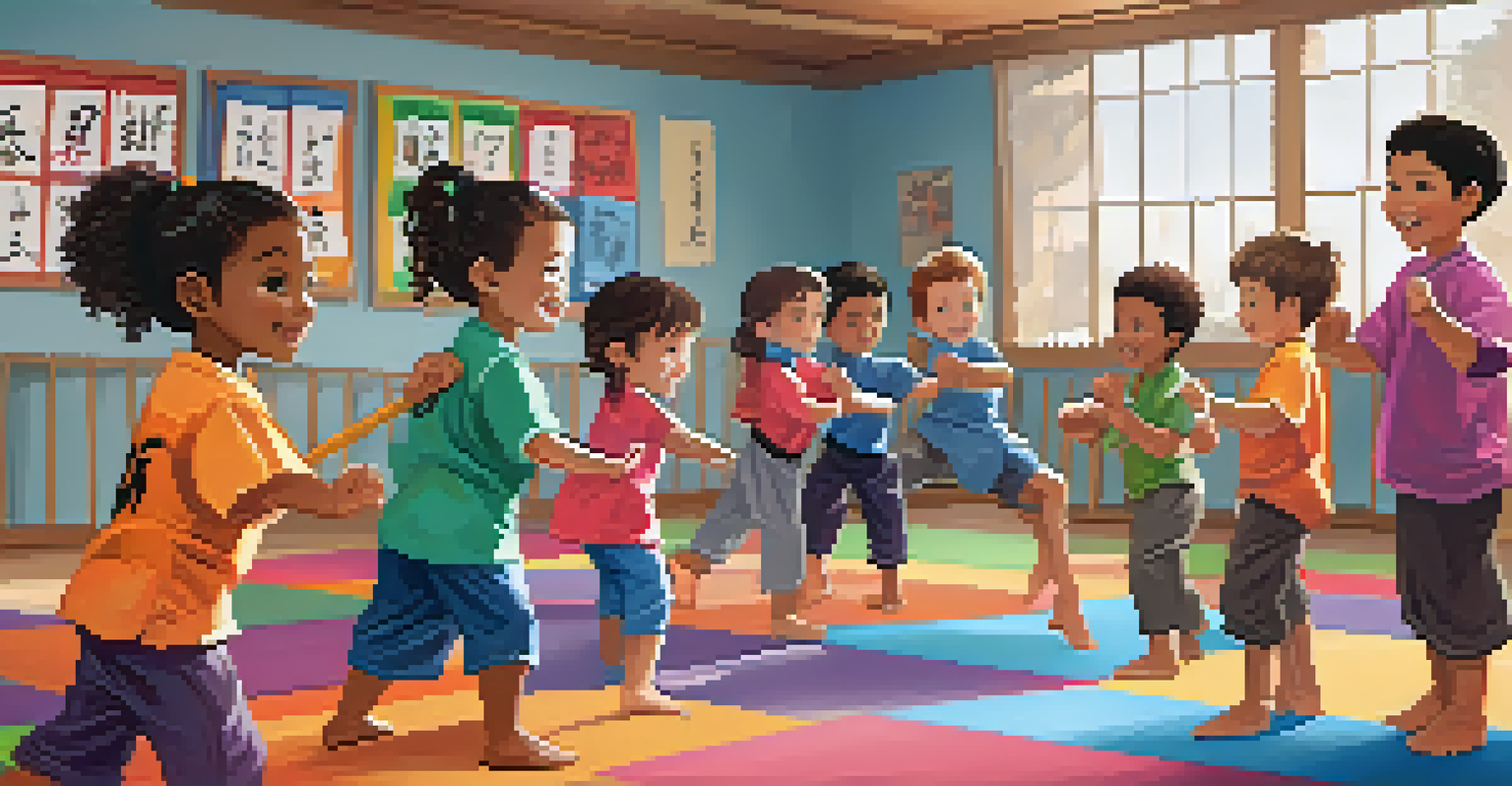Martial Arts: A Unique Approach to International Diplomacy

The Intersection of Martial Arts and Diplomacy
Martial arts have long been associated with discipline and respect, qualities that can significantly enhance diplomatic relations. By bringing together individuals from different cultures, martial arts create a platform for dialogue and understanding. Imagine two fighters from rival nations stepping onto the mat; they may start as opponents but can leave as friends, having shared an experience that transcends their differences.
Martial arts is not about the opponent; it’s about the self. The real challenge is to overcome your own limits and fears.
The practice of martial arts often emphasizes the importance of humility and patience. These traits are essential in diplomacy, where emotions can run high and misunderstandings are common. When martial artists train together, they learn to listen, adapt, and collaborate, skills that are directly transferable to international negotiations.
Moreover, martial arts provide a common language—physical movements and techniques that anyone can learn regardless of their background. This shared experience can break down barriers and foster camaraderie, making it easier for diplomats to engage with one another on a human level.
Cultural Exchange Through Martial Arts Events
International martial arts tournaments and exhibitions are more than just competitions; they are cultural festivals. These events attract participants and spectators from around the globe, showcasing different styles and traditions. For instance, a karate tournament in Japan may feature Brazilian jiu-jitsu practitioners, enabling both cultures to appreciate each other's techniques and philosophies.

Such cultural exchanges often lead to deeper relationships between nations. When athletes and their entourages travel to compete, they engage in dialogue, share meals, and often form lasting friendships. These personal connections can influence official diplomacy, creating a network of goodwill that can be drawn upon in times of need.
Martial Arts Foster Diplomacy
Martial arts create platforms for dialogue and understanding, allowing individuals from different cultures to connect beyond their differences.
Furthermore, hosting martial arts events can also be a strategic diplomatic move. Countries can use these platforms to showcase their hospitality and cultural richness, which can enhance their global reputation. As athletes and spectators leave with positive experiences, they become informal ambassadors for the host nation.
Promoting Peace Through Martial Arts Education
Martial arts schools around the world often emphasize peace and conflict resolution alongside physical training. By incorporating lessons on respect, empathy, and emotional control, these schools play a vital role in shaping young minds. Imagine a classroom where children learn how to resolve conflicts without violence, using the principles of martial arts as their guide.
The greatest victory is that which requires no battle.
Educational programs that integrate martial arts can foster a sense of community and belonging, which is essential in promoting social harmony. Schools that embrace these teachings create environments where students are encouraged to support one another, reducing the likelihood of bullying and conflict. This focus on community can ripple outwards, influencing larger societal dynamics.
Additionally, martial arts education can serve as a bridge between countries facing tensions. Collaborative training programs can be established, allowing youth from different nations to learn together, creating bonds that can last a lifetime. This early exposure to different cultures can help shape a generation that values understanding over hostility.
Martial Arts as a Tool for Conflict Resolution
In situations of conflict, martial arts can serve as an innovative tool for resolution. Techniques that teach individuals to control their aggression can be applied in diplomatic negotiations, where maintaining composure is crucial. Just as martial artists learn to redirect energy, diplomats can also learn to navigate heated discussions with grace.
Furthermore, the principles of martial arts—like the concept of yielding rather than resisting—can be valuable in diplomacy. By approaching conflicts with a mindset that prioritizes understanding and compromise, diplomats can find solutions that work for all parties involved. This approach can lead to more sustainable and peaceful outcomes.
Cultural Exchange Strengthens Ties
International martial arts events serve as cultural festivals, promoting relationships and goodwill between nations through shared experiences.
Moreover, workshops focused on martial arts techniques for conflict resolution can be conducted for diplomats and negotiators. These workshops would not only provide practical tools but also create a shared experience that fosters camaraderie among participants, ultimately strengthening international relations.
Case Studies: Successful Martial Arts Diplomacy
Several instances in history illustrate the potential of martial arts as a diplomatic tool. For example, the 1971 'Ping Pong Diplomacy' between the United States and China opened doors to communication and cooperation. Similarly, martial arts exchanges have led to improved relations between countries that have historically been at odds.
Another notable case is the relationship between Japan and Brazil, where both nations have significant populations of martial arts practitioners. Collaborative events and competitions have fostered a deeper appreciation for each other's culture, leading to strengthened ties and mutual respect. These examples underscore how martial arts can act as a catalyst for diplomatic progress.
Additionally, initiatives like the Martial Arts for Peace program highlight the effectiveness of these strategies in conflict-prone areas. By bringing together youth from different backgrounds to train together, they not only learn self-defense but also develop friendships that can pave the way for broader peace-building efforts.
The Role of Martial Arts in Global Unity
Martial arts promote a sense of global unity by celebrating diversity through shared practices. Events like the World Martial Arts Festival showcase various styles, encouraging participants to appreciate different perspectives. This celebration of diversity can help create a world where differences are seen as strengths rather than obstacles.
Moreover, martial arts organizations often have a global reach, uniting practitioners regardless of nationality. These organizations work towards common goals, such as promoting health and well-being, which can transcend political borders. When people come together for a shared purpose, it fosters a sense of belonging and interconnectedness, vital for global harmony.
Education Promotes Peaceful Conflict Resolution
Martial arts education emphasizes respect and empathy, equipping young minds with conflict resolution skills that can shape a more harmonious society.
In essence, martial arts can serve as a bridge, connecting individuals from different corners of the world. By fostering relationships built on respect and shared experiences, martial arts can contribute to a more peaceful and united planet.
Conclusion: The Future of Martial Arts in Diplomacy
The potential for martial arts as a tool for diplomacy is vast and largely untapped. As global tensions persist, innovative approaches to fostering peace are needed, and martial arts offer a unique avenue for connection. By embracing the values inherent in martial arts, diplomats can find new pathways to understanding and cooperation.
Looking ahead, integrating martial arts into educational and diplomatic initiatives could yield significant benefits. Programs that emphasize collaboration and mutual respect can help build a foundation for future generations. With the world becoming increasingly interconnected, now is the time to harness the power of martial arts for positive change.

Ultimately, the journey towards global peace and understanding may very well be found on the dojo mat. As more individuals recognize the potential of martial arts in diplomacy, we may see a shift in how nations engage with one another—fostering a world where dialogue triumphs over discord.